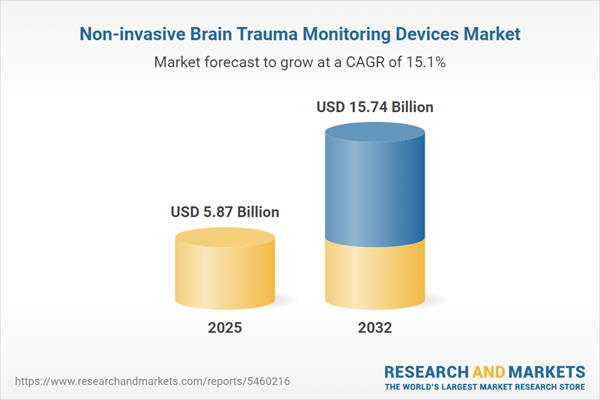Speak directly to the analyst to clarify any post sales queries you may have.
Non-invasive brain trauma monitoring devices are rapidly transforming how organizations address neurological care, streamlining operational processes and supporting flexible deployment across a range of clinical settings. These advancements make it possible for senior leaders to implement tailored technology strategies that improve patient outcomes and overall care delivery.
Market Snapshot: Non-Invasive Brain Trauma Monitoring Devices Market
Currently valued at USD 5.10 billion, the non-invasive brain trauma monitoring devices market is expected to reach USD 5.87 billion by 2025 and grow further to USD 15.74 billion by 2032, propelled by a compound annual growth rate of 15.10%. This expansion reflects companies' responses to heightened demand for timely neurological assessments, strategic investments in healthcare infrastructure, and the widespread adoption of adaptive digital monitoring platforms. C-suite executives are focusing on technology adoption, strategic partnerships, and procurement optimization to strengthen neurological care capabilities while driving organizational efficiency within complex healthcare environments.
Scope & Segmentation of the Non-Invasive Brain Trauma Monitoring Devices Market
Understanding the diverse segments of the non-invasive brain trauma monitoring devices market is essential for aligning technology investments with evolving patient, clinical, and operational demands. Each segment reveals different routes for adapting to shifting market and care requirements.
- Product Types: Stationary diagnostic systems such as CT and MRI equipment deliver detailed imaging essential for advanced neurological care. Intracranial pressure monitors are designed for immediate clinical insights. Wearable headbands and sensor-integrated helmets support continuous monitoring in both acute hospital and decentralized, remote environments.
- Applications: Devices play a key role in concussion management for sports and defense sectors, enable ongoing neurological oversight, support rehabilitation planning, assist with surgical protocols, and provide rapid trauma response across provider settings.
- End Users: Hospitals, outpatient clinics, home healthcare teams, military units, sports medicine professionals, research centers, and community organizations rely on these solutions, each facing unique integration and workflow needs based on their operating context.
- Technologies: Wireless EEG, functional and diffusion MRI, near-infrared spectroscopy, and Doppler ultrasound enable clinicians to perform rapid assessments and real-time neurological monitoring. These technologies enhance both routine patient care and the response to emergent events.
- Distribution Channels: Devices are distributed through OEM sales, partnerships with distributors, online marketplaces, and various e-commerce platforms, which increases procurement agility and helps strengthen industry-wide supply chain resilience.
- Geographies: Significant market activity is observed in regions such as the Americas, Europe, Middle East and Africa, and Asia-Pacific. Each region presents specific considerations, including regulatory variations, reimbursement models, and healthcare readiness, prompting organizations to shape region-specific adoption strategies.
- Leading Companies: Market leadership comes from Masimo Corporation, Medtronic plc, Edwards Lifesciences Corporation, GE HealthCare Technologies Inc., Koninklijke Philips N.V., Natus Medical Incorporated, NIHON KOHDEN Corporation, Nonin Medical, BrainScope Company, and Compumedics Limited.
Key Takeaways for Executive Strategy
- Wearable and remote brain monitoring devices offer critical early intervention opportunities for neurological care in diverse settings such as sports, defense, and home healthcare.
- Regionalized supply chains allow organizations to respond more dynamically to evolving procurement requirements and regulatory shifts, enhancing long-term device availability.
- Integrating cloud-based analytics into monitoring systems supports secure, streamlined data sharing, which in turn improves cross-disciplinary diagnostics and care team coordination.
- Incorporating artificial intelligence and modular hardware designs helps organizations quickly adapt protocols and clinical workflows to align with the latest advances and guidelines.
- New applications emerging in emergency care, collaborative research, and military medicine create additional growth opportunities and promote innovative partnership models within the sector.
- Building strong relationships between manufacturers and clinicians leads to standardized device usage and aids faster, more efficient adoption, improving the quality of neurological care across healthcare networks.
Tariff Impact: Navigating Policy Shifts and Supply Chain Realignment
Recent policy changes in United States tariff regulations have raised new cost considerations for key device components. To address these pressures, organizations are increasing domestic manufacturing, optimizing regulatory review processes, and reinforcing their local supply chains. Such efforts help manage uncertainties, enhance U.S.-based research, and maintain stable, high-quality device availability for domestic providers.
Methodology & Data Sources
Findings are based on structured interviews with clinical leadership, manufacturers, and regulatory agencies. These insights are validated through peer-reviewed literature, patent analysis, adherence to industry standards, and regular compliance audits to assure accuracy and relevance.
Why This Report Matters
- Provides senior executives with targeted intelligence to anticipate market changes and make informed technology investment decisions.
- Supports agile adaptation by delivering advanced benchmarking and timely analysis tailored to shifts in both clinical best practices and healthcare policy.
- Enhances risk management, uncovers high-value collaboration opportunities, and lays the groundwork for innovation in enterprise healthcare planning.
Conclusion
Senior strategists can leverage the actionable insights in this report to guide neurological care transformation, plan confidently, and drive sustained success within an evolving health sector.
Additional Product Information:
- Purchase of this report includes 1 year online access with quarterly updates.
- This report can be updated on request. Please contact our Customer Experience team using the Ask a Question widget on our website.
Table of Contents
3. Executive Summary
4. Market Overview
7. Cumulative Impact of Artificial Intelligence 2025
Companies Mentioned
The companies profiled in this Non-invasive Brain Trauma Monitoring Devices market report include:- Masimo Corporation
- Medtronic plc
- Edwards Lifesciences Corporation
- GE HealthCare Technologies Inc.
- Koninklijke Philips N.V.
- Natus Medical Incorporated
- NIHON KOHDEN Corporation
- Nonin Medical, Inc.
- BrainScope Company, Inc.
- Compumedics Limited
Table Information
| Report Attribute | Details |
|---|---|
| No. of Pages | 180 |
| Published | October 2025 |
| Forecast Period | 2025 - 2032 |
| Estimated Market Value ( USD | $ 5.87 Billion |
| Forecasted Market Value ( USD | $ 15.74 Billion |
| Compound Annual Growth Rate | 15.1% |
| Regions Covered | Global |
| No. of Companies Mentioned | 11 |









